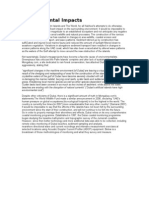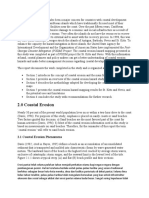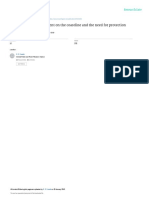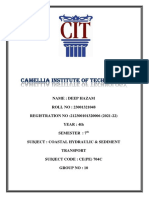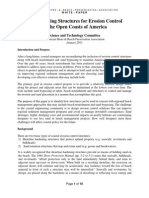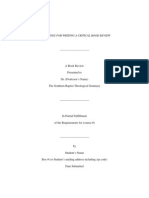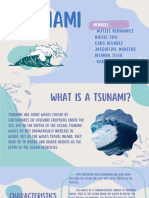Smit
Smit
Uploaded by
Buddin A. HakimCopyright:
Available Formats
Smit
Smit
Uploaded by
Buddin A. HakimOriginal Description:
Copyright
Available Formats
Share this document
Did you find this document useful?
Is this content inappropriate?
Copyright:
Available Formats
Smit
Smit
Uploaded by
Buddin A. HakimCopyright:
Available Formats
Proceedings of the 14th Biennial Coastal Zone Conference
New Orleans, Louisiana
July 17 to 21, 2005
QUANTIFYING AND MANAGING THE COASTAL RESPONSE TO
MAJOR OFFSHORE DEVELOPMENTS IN DUBAI
Francois Smit, Coastal Management Section, Dubai Municipality
Gary P. Mocke, Coastal Management Section, Dubai Municipality
Khalid M. Al Zahed, Coastal Management Section, Dubai Municipality
Keywords: coastal monitoring, coastal zone management, offshore developments, Dubai,
coastal response, sustainable development, legislation
INTRODUCTION
The coastline of Dubai has undergone rapid transformation over the last 20 years due to
significant infra-structural development on its shores, including the construction of a
number of fishing harbors and two major port facilities. These changes have interfered
with the natural sediment transport processes and have resulted in beach erosion and loss
of amenity value in places. A number of high profile developments involving extensive
land reclamation in the offshore area have accelerated the rate of shoreline change in
recent years. Steps taken by the Coastal Management Section of Dubai Municipality to
address these issues include the set up of an extensive coastal zone monitoring program
(http://www.dubaicoast.org/), numerical and physical modeling to assist in coastal
process understanding and in developing and assessing coastal management options, and
investigations into suitable sand sources for beach nourishment. This is done within the
framework of a comprehensive Coastal Zone Management Plan and supporting
legislation being drawn up for the region.
Features of the monitoring program include regular topographic and bathymetric surveys,
remote video monitoring of Dubai beaches, satellite image analysis, sediment sampling
and analysis, continuous nearshore directional wave and current recordings and wave and
current measurement exercises at specific locations of interest.
Statutory efforts so far have led to the proclamation of a decree (Decree 22 (2001))
protecting all coastal sand resources in a zone stretching 10 nautical miles offshore and
one kilometer inshore. In terms of the legislation any excavation, sand removal or
dredging activities require the necessary prior approvals from the Municipality. The
Municipality has first right on any excess sand not used on site and typically stockpiles
material of suitable quality for nourishing beaches where required.
DUBAI COASTAL MANAGEMENT CONTEXT
Situated on the south-eastern end of the Arabian Gulf, the coastal regime of Dubai is
characterised by weak tidal currents, a tidal range of approximately 1.0 m - 1.75 m and
the occurrence of north-westerly (shamal) winds that blow along the length of the Gulf.
These shamals are the principal wave generating force and mainly occur during the
winter months. During shamal conditions wave periods are typically in the range of 7 s
8 s, with significant wave heights in the range 1 m to 2 m. These events typically last for
1 to 3 days. Figure 1 depicts a prediction of wave heights from the US Navy
Proceedings of the 14th Biennial Coastal Zone Conference
New Orleans, Louisiana
July 17 to 21, 2005
Oceanographic Office
showing wave heights
resulting from a severe
shamal moving along the
Arabian Gulf in February
2003. The accompanying
table summarizes typical
design wave heights.
Table 1: Dubai Offshore Design Wave Heights
Return Period (yr)
Hs (m)
1
3.4
10
4.2
50
4.7
100
4.9
200
5.2
Sediment transport is
predominantly wave-driven
and generally directed from
southwest to northeast.
Potential transport rates
vary between 20,000 m3/yr
Dubai
in the north-east to 40,000
3
m /yr in the south-west,
depending on the
orientation of the coastline.
The presence of numerous
structures along the
coastline has interrupted the
Figure 1: WAM model prediction of significant wave
natural littoral drift with
heights in Arabian Gulf.
resultant deposition of
sediments on the updrift and erosion on the downdrift sides of these structures (see Figure
2).
The Coastal Management Section of the
Dubai Municipality is responsible for
longshore drift
managing Dubais coastline. The
direction
section has both an operational and
erosion
strategic function. The operational role
relates mainly to the management and
technical review of coastal and marine
engineering projects conducted under
the authority of the Dubai Municipality.
Figure 2: Interruptions of the natural
This extends to the monitoring and
longshore drift of sediment (from southmaintenance of past and ongoing
east to north-west).
projects. On a strategic level the
Coastal Management Section has a primary responsibility to ensure sufficient expertise
and knowledge (i.e. data) and analysis (i.e. modeling) resources are available within the
Municipality. This includes the formulation and supervision of an ongoing Coastal Zone
Monitoring Program (Smit, et al, 2003) and any necessary coastal development design
studies. A further responsibility relates to the drawing up of coastal development
guidelines for incorporation in codes of practice and eventual passage to legislation.
Proceedings of the 14th Biennial Coastal Zone Conference
New Orleans, Louisiana
July 17 to 21, 2005
To ensure these responsibilities are met two units were established within the Section,
namely the Marine Works Unit and the Coastal Monitoring and Design unit. Main
functions of the Marine Works Unit include: managing and supervising current and future
port, marine and coastal engineering projects; issuing of no-objection certificates (NOC)
for coastal construction and dredging; providing for and supervising regular maintenance
for all coastal and marine elements along the Dubai coastline; anticipating and mitigating
against potential environmental impacts of coastal development projects; and supervising
sand source surveys and investigations.
The Coastal Monitoring and Design Unit is responsible for: developing, implementing
and maintaining a comprehensive field monitoring program and database; providing
specialist advice to Municipality departments and other organizations in Dubai
concerning marine and coastal issues; developing a thorough quantitative understanding
of marine processes in the Dubai coastal zone; developing expertise within the Coastal
Management Section through training and technology transfer; developing and applying
analytical and numerical predictive modeling capabilities; and developing specifications,
codes and guidelines for planning and legislation related to existing and future
development in the coastal zone.
The staff in the Coastal Management Section has a high level of expertise, consisting of
professional coastal and liaison engineers and proficient support staff.
COASTAL RESPONSE TO MAJOR COASTAL DEVELOPMENTS
A number of major coastal developments involving major dredging and reclamation are
under way or have been announced for Dubai. The most significant of these are the Palm
Islands and World developments shown in Figure 3. As a result of such developments
the coastline has responded rapidly over the last couple of years. Depicted in Figure 4
below are surveyed coastlines (represented by the +2m DMD contour) for 1981, 1991,
1996, April 2000, August 2002, January 2003, April 2003, May 2004 and January 2005
of the beach southwest of the recreational harbour of Mina Al Seyahi. The area is located
within the southwest shadow of Palm Jumeirah, as indicated on Figure 5, where net
sediment transport is from southwest to northeast. The coastline had been slowly
accreting with the beach building up next to the harbour breakwater between 1981 and
1991. Following the addition of the spur to the breakwater around 1994 the beach built
up rapidly as indicated by the location of the 1996 coastline. The coastline then
continued its slow build-up to reach the locations indicated by the April 2000 and
September 2001 coastlines. With Palm Island taking shape in 2002 the situation changed
and the coastline grew rapidly, as indicated by the August 2002 to January 2005
coastlines. The average shoreline accretion rate over this period in the area is in the range
of 30 metres per year.
The reason for this rapid buildup is related to the differential wave sheltering effect of
the offshore island. This is depicted in Figure 6 as a numerical wave refraction run
indicating the wave shadow cast by Palm Island for waves approaching from the northwest, the principal offshore wave direction. The results are presented as a difference map
indicating the difference in wave height with Palm Island excluded and included in the
Proceedings of the 14th Biennial Coastal Zone Conference
New Orleans, Louisiana
July 17 to 21, 2005
Palm Jebel Ali
The World
Palm Jumeirah
2.5
10
15
Kilometers
20
Figure 3: Overview of major offshore development projects
refraction model. The northerly waves are essentially removed from the nearshore wave
regime at Mina Al Seyahi through the presence of Palm Island. These waves represent a
transport component directed in the opposite direction of the net transport direction and
provided a dampening of the net alongshore transport rate. With these waves removed
from the nearshore environment the north-eastward directed net transport rate increased
and the rapid build-up of the coastline occurred.
Proceedings of the 14th Biennial Coastal Zone Conference
New Orleans, Louisiana
July 17 to 21, 2005
Figure 5: Stretch of beach between
Mina Al Seyahi and Dubai Marina
Southern Entrance with Palm Jumeirah
to the north (right)
Figure 6: Influence of Palm Island on
nearshore wave regime as calculated
using refraction model for waves
approaching from a direction of 315 N.
Figure 4: Surveyed coastlines southwest of Mina Al Seyahi for period 1981 to 2003.
The accumulation of sediment updrift of Mina Al Seyahi harbour is balanced by a loss of
sand along the shoreline to the south. The Coastal Management Section has drawn on
this qualitative information gained from the monitoring program to screen applications
for developments on the coast at this and other affected sites, ensuring that a buffer
development setback zone is allowed for.
Proceedings of the 14th Biennial Coastal Zone Conference
New Orleans, Louisiana
July 17 to 21, 2005
CONCLUSIONS
The Coastal Management Section of Dubai Municipality attempts to quantify the
dynamic coastal response to extensive major development projects by both monitoring
and coastal modeling, with the latter providing predictions of future evolution of the
coast. This understanding is brought to bear when implementing the provisions of coastal
management legislation, in particular project municipal permitting requirements.
LITERATURE CITED
Smit, F., Mocke, G.P. and Al Zahed, K.M. 2003. Dubai Coastal Zone Monitoring
Programme. Proceedings of the 6th International Conference on Coastal and Port
Engineering in Developing Countries (COPEDEC), Colombo, Sri Lanka.
Francois Smit
Coastal Management Section
Dubai Municipality
PO Box 360
Dubai, United Arab Emirates
Tel: +971 4 206 4515
Email: marineu@dm.gov.ae
You might also like
- Geography Assessment Term 1 Yr10Document10 pagesGeography Assessment Term 1 Yr10yeetjoethefoeNo ratings yet
- Conservation and Protection of Estuaries Andmintertidal Zones Lesson PlanDocument5 pagesConservation and Protection of Estuaries Andmintertidal Zones Lesson PlanPaciano Cansing100% (1)
- StormGeo TARGET - JUBAIL AREA 2022021600Document4 pagesStormGeo TARGET - JUBAIL AREA 2022021600gruNo ratings yet
- Coastal Engineering ManualDocument8 pagesCoastal Engineering ManualGerry RobertsNo ratings yet
- Environmental Impacts IonDocument10 pagesEnvironmental Impacts Ionosam69No ratings yet
- Coastal Regulation Zone Notification 2011Document5 pagesCoastal Regulation Zone Notification 2011AayshaNo ratings yet
- Palm IslandDocument12 pagesPalm IslandDon Francis100% (1)
- 2.0 Coastal Erosion: Georges Disaster Mitigation (PGDM) Project. The Coastal Erosion Hazard Mapping Presented inDocument14 pages2.0 Coastal Erosion: Georges Disaster Mitigation (PGDM) Project. The Coastal Erosion Hazard Mapping Presented inAndi Azizah FebiyantiNo ratings yet
- 2.0 Coastal Erosion: Georges Disaster Mitigation (PGDM) Project. The Coastal Erosion Hazard Mapping Presented inDocument14 pages2.0 Coastal Erosion: Georges Disaster Mitigation (PGDM) Project. The Coastal Erosion Hazard Mapping Presented inAndi Azizah FebiyantiNo ratings yet
- Design and Performance of Artificial Beaches For The Kuwait Waterfront ProjectDocument14 pagesDesign and Performance of Artificial Beaches For The Kuwait Waterfront ProjectSujanNepalNo ratings yet
- Anthropogenic Effects On Shoreface and Shoreline Changes Input From ADocument16 pagesAnthropogenic Effects On Shoreface and Shoreline Changes Input From AAnas ZayounNo ratings yet
- Sand Beach Nourishment: Experience From The Mediterranean Coast of IsraelDocument18 pagesSand Beach Nourishment: Experience From The Mediterranean Coast of Israellevberger19890No ratings yet
- Coastal Planning Management Lesson1-OverviewDocument57 pagesCoastal Planning Management Lesson1-OverviewshirleyNo ratings yet
- Coastal Protection SrilankaDocument1 pageCoastal Protection SrilankaEranga Alwis100% (1)
- Impactof PortsDocument9 pagesImpactof PortsAzisNo ratings yet
- Coastal Erosion Fact SheetDocument4 pagesCoastal Erosion Fact SheetThenmolle RamanathanNo ratings yet
- Water Management and Flood Control in GuyanaDocument47 pagesWater Management and Flood Control in GuyanaRyan BoodramlallNo ratings yet
- DHI Coast Marine Coastal Engineering OverView FlyerDocument2 pagesDHI Coast Marine Coastal Engineering OverView FlyerDwi Oktia RiniNo ratings yet
- Teknik PantaiDocument3 pagesTeknik PantaiGsp PaulusNo ratings yet
- 04 Content PDFDocument288 pages04 Content PDFabdul muhyiNo ratings yet
- Interference With Coastal Structures: o o o oDocument6 pagesInterference With Coastal Structures: o o o oROSALIE AGMALIWNo ratings yet
- Interference With Coastal Structures: o o o oDocument6 pagesInterference With Coastal Structures: o o o oROSALIE AGMALIWNo ratings yet
- Water Management and Flood Control in GuyanaDocument48 pagesWater Management and Flood Control in GuyanaHanniel MadramootooNo ratings yet
- Ocean & Coastal Management: K. Thiruvenkatasamy, D.K. Baby GirijaDocument14 pagesOcean & Coastal Management: K. Thiruvenkatasamy, D.K. Baby GirijaErnesto RodriguezNo ratings yet
- B.E. Civil Engineering Seminar Report: Palm Islands Submitted byDocument11 pagesB.E. Civil Engineering Seminar Report: Palm Islands Submitted bymahipal287No ratings yet
- Coastal Engineering - Lecture 2: Coastal Structures - Case Studies Soft & Hard MeasuresDocument31 pagesCoastal Engineering - Lecture 2: Coastal Structures - Case Studies Soft & Hard MeasuresNick Dylan Darrel ProsperNo ratings yet
- Submission Sand Management UpdatedDocument3 pagesSubmission Sand Management UpdatedMichael O'CallaghanNo ratings yet
- GROUP B BATHY REPORTDocument36 pagesGROUP B BATHY REPORTchibuikeoparah7No ratings yet
- Ocean and Coastal Management: Nelson Rangel-Buitrago, Victor N. de Jonge, William NealDocument10 pagesOcean and Coastal Management: Nelson Rangel-Buitrago, Victor N. de Jonge, William NealBaluNo ratings yet
- Prevention & Mitigation of The Impact of Coastal Processes, Land Development & Waste DisposalDocument29 pagesPrevention & Mitigation of The Impact of Coastal Processes, Land Development & Waste DisposalClaire Estimada100% (2)
- Appendix C1 DEIRDocument25 pagesAppendix C1 DEIRL. A. PatersonNo ratings yet
- The Gambia Coastal Erosion Case Studies - YT2012 PDFDocument12 pagesThe Gambia Coastal Erosion Case Studies - YT2012 PDFYusef_TaylorNo ratings yet
- Meghna Estuary StudyDocument16 pagesMeghna Estuary Studyminhaz21No ratings yet
- Coastal Protection StructuresDocument107 pagesCoastal Protection StructuresKhrl K Khrl88% (8)
- Morocco MiningDocument8 pagesMorocco MiningjdkgldkdlsNo ratings yet
- Coastal Hydraulic & Sediment TransportDocument15 pagesCoastal Hydraulic & Sediment TransportSuman HazamNo ratings yet
- Dipen - Simulation of Longshore Sediment at Kuakata - ISOR-JMCEDocument17 pagesDipen - Simulation of Longshore Sediment at Kuakata - ISOR-JMCEataur91No ratings yet
- Modelling Coastal Sediment Transport For Harbour Planning: Selected Case StudiesDocument25 pagesModelling Coastal Sediment Transport For Harbour Planning: Selected Case StudiesMonika KshNo ratings yet
- Report On Coastal Protection StructuresDocument12 pagesReport On Coastal Protection Structureskxfhmhx5kxNo ratings yet
- Beach Morphological Characteristics in Blue Flag BeachesDocument21 pagesBeach Morphological Characteristics in Blue Flag BeachesJemeemabrindhaNo ratings yet
- Tugas Pertemuan 14-Amelia Rizqiyanti-3336180026-MPK-Jurnal 2Document9 pagesTugas Pertemuan 14-Amelia Rizqiyanti-3336180026-MPK-Jurnal 2Diki SetiawanNo ratings yet
- Aerial Oblique View of The Happisburgh To Winterton Sea DefencesDocument5 pagesAerial Oblique View of The Happisburgh To Winterton Sea DefencesEduardo CervantesNo ratings yet
- 1 - Rockaway Draft Integrated HSGRR and EISDocument270 pages1 - Rockaway Draft Integrated HSGRR and EISPeter J. MahonNo ratings yet
- Engr. Eric C. CruzDocument5 pagesEngr. Eric C. CruzJun KhoNo ratings yet
- Gral 22Document12 pagesGral 22claudioNo ratings yet
- Technical Posters: The Error Index For Beach Planform ModelsDocument7 pagesTechnical Posters: The Error Index For Beach Planform ModelssujitstayadeNo ratings yet
- Changes in Coastal Sediment Transport PRDocument12 pagesChanges in Coastal Sediment Transport PRKhalid ArafatNo ratings yet
- Technical Analysis On The Manila BayDocument16 pagesTechnical Analysis On The Manila BayPaul Rye SolivenNo ratings yet
- ReintroducingStructuresforErosionControlFINAL PDFDocument10 pagesReintroducingStructuresforErosionControlFINAL PDFBenedictus JohanesNo ratings yet
- Analysis of Rate of Shoreline Changes Along The Coastline of Kuala TerengganuDocument9 pagesAnalysis of Rate of Shoreline Changes Along The Coastline of Kuala TerengganuWAN AMRUL JAAHIZ WAN ABD RAZAKNo ratings yet
- Water 12 00346 PDFDocument26 pagesWater 12 00346 PDFMeor Asyraf Rostam AffandiNo ratings yet
- Soft Eng Techniques For Coastal ProtectionDocument49 pagesSoft Eng Techniques For Coastal ProtectionHaryo ArmonoNo ratings yet
- CoastalDocument35 pagesCoastalmrshautsonNo ratings yet
- 17 - 2 - 36 - MAPE (Error Persen)Document18 pages17 - 2 - 36 - MAPE (Error Persen)Fauzan Kholistya HanifNo ratings yet
- 5 Mitigation of The Impacts of Land Development Waste Disposal and Construction On CoastsDocument3 pages5 Mitigation of The Impacts of Land Development Waste Disposal and Construction On CoastsPaui Parado Eran50% (2)
- Namibia - Strategic Expansion of The Walvis Bay Container Terminal Project - Executive Esia SummaryDocument26 pagesNamibia - Strategic Expansion of The Walvis Bay Container Terminal Project - Executive Esia SummaryblairkayandouinusebNo ratings yet
- Dredging and Reclamation WorksDocument9 pagesDredging and Reclamation WorksWellfroNo ratings yet
- Okwuosa ValentinoDocument24 pagesOkwuosa ValentinoOlugbode DavidNo ratings yet
- 5.mitigation of The Impacts of Land Development, Waste Disposal, and Construction On CoastsDocument3 pages5.mitigation of The Impacts of Land Development, Waste Disposal, and Construction On CoastsJay Bee82% (22)
- Coastal Geomorphology: Processes, Landforms, and Human InteractionsFrom EverandCoastal Geomorphology: Processes, Landforms, and Human InteractionsNo ratings yet
- Multihazard Risk Atlas of Maldives: Geography—Volume IFrom EverandMultihazard Risk Atlas of Maldives: Geography—Volume IRating: 5 out of 5 stars5/5 (1)
- Multihazard Risk Atlas of Maldives: Biodiversity—Volume IVFrom EverandMultihazard Risk Atlas of Maldives: Biodiversity—Volume IVNo ratings yet
- Indonesia GODAR ReportDocument4 pagesIndonesia GODAR ReportBuddin A. HakimNo ratings yet
- Ocean and Coastal MonitoringDocument1 pageOcean and Coastal MonitoringBuddin A. HakimNo ratings yet
- Environmental Management AccountingDocument2 pagesEnvironmental Management AccountingBuddin A. HakimNo ratings yet
- Grain SizeDocument2 pagesGrain SizeBuddin A. HakimNo ratings yet
- 26 April 2011Document1 page26 April 2011Buddin A. HakimNo ratings yet
- Environmental Management AccountingDocument2 pagesEnvironmental Management AccountingBuddin A. HakimNo ratings yet
- Book Review GuideDocument5 pagesBook Review GuideBuddin A. HakimNo ratings yet
- ReferensiDocument1 pageReferensiBuddin A. HakimNo ratings yet
- Pp82th 2001 Pengelolaankualitasairdanpengendalianpencemaranair 120330022309 Phpapp01Document203 pagesPp82th 2001 Pengelolaankualitasairdanpengendalianpencemaranair 120330022309 Phpapp01La Ode Muhammad ErifNo ratings yet
- 4 - English - Vocabulary - in - Use - Advanced - Cambridge - Third - Edition Page 66Document1 page4 - English - Vocabulary - in - Use - Advanced - Cambridge - Third - Edition Page 66Linchie NguyễnNo ratings yet
- El Nino Is A Weather Phenomenon Caused When Warm Water From The Western Pacific Ocean Flows EastwardDocument2 pagesEl Nino Is A Weather Phenomenon Caused When Warm Water From The Western Pacific Ocean Flows Eastwardabirami sNo ratings yet
- The Oceans Are So Vast and Deep That Until Fairly RecentlyDocument2 pagesThe Oceans Are So Vast and Deep That Until Fairly Recentlyapi-238935710No ratings yet
- Earth and Its SubsystemsDocument9 pagesEarth and Its SubsystemsRalph EspejoNo ratings yet
- Bataan Coastal Land and Sea Use Zoning Plan ch3Document88 pagesBataan Coastal Land and Sea Use Zoning Plan ch3nylence1986No ratings yet
- Presentacion en InglesDocument9 pagesPresentacion en InglesAlitzel HernándezNo ratings yet
- Marine PollutionDocument11 pagesMarine PollutionaniNo ratings yet
- Classic - Examples Surface TemperaturDocument32 pagesClassic - Examples Surface TemperaturMuh FaisalNo ratings yet
- 5th Grade Science Weather Vocabulary CardsDocument2 pages5th Grade Science Weather Vocabulary Cardsapi-290509627No ratings yet
- Design Criteria Data: Seoul East, South KoreaDocument18 pagesDesign Criteria Data: Seoul East, South Korea김동욱No ratings yet
- ResourcesDocument5 pagesResourcesJhanvipooNo ratings yet
- BIO330 - 2305 Test 1 EditedDocument4 pagesBIO330 - 2305 Test 1 EditedNURUL AINUN MUHAMMAD NORNo ratings yet
- Mil HDBK 310Document123 pagesMil HDBK 310plaunieNo ratings yet
- Sea Surface Temperature - WikipediaDocument9 pagesSea Surface Temperature - WikipediaBrayan Anderson Chumpen CarranzaNo ratings yet
- Continental Shelf ResearchDocument13 pagesContinental Shelf Researchnatss mateoNo ratings yet
- ROJAN ScienceDocument6 pagesROJAN ScienceRica CalaguasNo ratings yet
- Class VII Social Science (Geography) Notes Chapter 5 WaterDocument37 pagesClass VII Social Science (Geography) Notes Chapter 5 WaterArtham ResourcesNo ratings yet
- Plate Tectonic Theory Is Proved To Be Wrong by Scientist.G.PonmudiDocument1 pagePlate Tectonic Theory Is Proved To Be Wrong by Scientist.G.Ponmudig.ponmudiNo ratings yet
- Online WordpadDocument1 pageOnline Wordpadmovieexclusive02No ratings yet
- Climate Variability and Climate Change 2016Document91 pagesClimate Variability and Climate Change 2016Laila Guarin100% (1)
- Weather VocabularyDocument12 pagesWeather Vocabularysara montillaNo ratings yet
- Clear Air TurbulanceDocument2 pagesClear Air TurbulanceAchmad Arifudin HidayatullohNo ratings yet
- Wind WeatherDocument9 pagesWind WeatheroffshorearmadaNo ratings yet
- The Gambia Coastal Erosion Case Studies - YT2012 PDFDocument12 pagesThe Gambia Coastal Erosion Case Studies - YT2012 PDFYusef_TaylorNo ratings yet
- Latihan Structure - Written Expression and Reading ComprehensionDocument4 pagesLatihan Structure - Written Expression and Reading ComprehensionFaridMuhamadNo ratings yet
- Climate ZonesDocument2 pagesClimate Zonesapi-308047560No ratings yet
- Ecosystem Summary NotesDocument5 pagesEcosystem Summary Notespalak singhNo ratings yet




